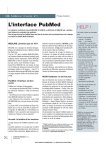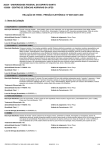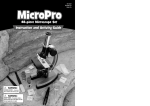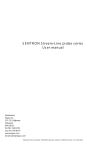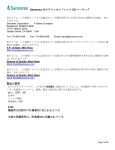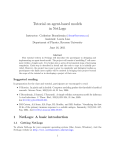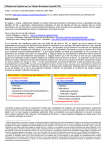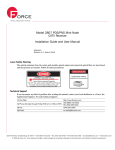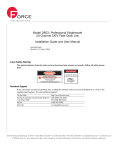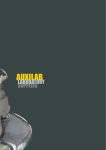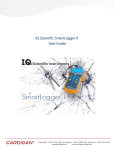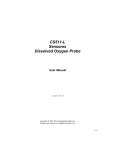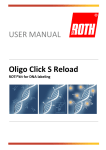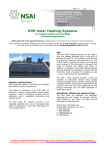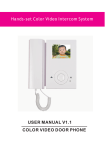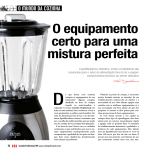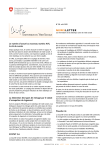Download Newsletter 2007-10x
Transcript
NEWSLETTER October 2007 TOPICS: 1. 2. 3. 4. 5. 6. 7. 8. Newsletter Mail List SENSOR BREAKAGE — PLEASE READ!!! SOLID STATE pH Probes CLEANING pH Probes for extended life The Latest on Ammonia, Methane, Carbon Dioxide, and Pressure Hardware Upgrades in the Current Design NEW SOFTWARE RELEASE SOON…..V6.10 DASCOR Contact Information N EWSLETTER M AIL L IST: This newsletter is being sent to everyone who has contacted us regarding DASCOR’s LRCpH Ruminal Data Loggers and provided an email address. The newsletter will be used primarily to bring you up to date on our current technology and marketing efforts, and announce changes in performance, new software releases, and technical notes on relevant topics. It will be sent on an irregular, as-needed basis. Contributions and requests for information are more than welcome. However, if you are not interested in receiving it, please let us know! SENSOR BREAKAGE — PLEASE READ!!! According to the pH probe manufacturer (Sensorex), more than 98% of pH electrodes will reach you in excellent working condition. Probes that fail during normal handling or during first use may be returned for possible warranty replacement. Sensorex will examine the glass fracture surfaces, and can easily identify and differentiate failures caused by manufacturing stress crack defects, or by mechanical causes such as impacts. So, if you feel a probe failure was premature, and was not caused by dropping, or impacting the weights, rocks, or tramp metal in the rumen, then return the cleaned sensor to DASCOR (freight prepaid), and we will have it examined. A replacement will be provided by Sensorex if the failure is determined to be manufacturing related, such as stress fracture, electrical short or open, or other workmanship or material issues. The most fragile shape for a pH sensor is the spherical lab style. Second in line is the flat face. The most robust shape is the hemisphere. There are minor trade-offs between glass thickness, sensitivity, and surface area that give the hemispherical shape roughly the same performance as the flat glass electrodes, but with improved strength. Sensorex tells me that the increase in strength is roughly 5:1. HOWEVER, and this is important, any glass shape can be broken if it is struck by a hard object, or has too much pressure applied to it. Also, with the hemispherical probes, there is more exposure of the glass, and the potential for impact is increased. DASCOR Newsletter 2007-10x.doc 11/28/2007 www.dascor.com [email protected] Page 1 of 6 In an ongoing effort to increase the life expectancy of the pH sensors, and on the recommendation of the manufacturer, all of the sensors that we have shipped recently have been changed to a new part number: 971761. The new sensors are identical in function to the S655CD-HT’s we have been delivering, and include the gel reference electrolyte. However, the S655’s have a flat glass electrode, while the 971761’s have a hemispherical glass electrode. Over the past few years, approximately 15 sensors have been returned to DASCOR, of which 1 or 2 were covered by warranty replacements. This is in keeping with a <2% failure rate. The remainder were clearly damaged in use, and not covered by warranty. The good news is that we have identified a possible cause and cure for electrode glass breakage. Please examine the photographs below. Note that if the wire-ties connecting the weights to the shield are around the bottom ring, there is a strong probability that the weights can swing into the sensor area and impact the glass. We believe this has been the major cause of previous glass breakage. The cure is simply to move the attachment to the vertical struts, keeping the connecting loop fairly short. The weights will have adequate freedom of motion, and will continue to hold the logger in the proper position—but will not be able to impact the glass. DO NOT ATTACH THE WEIGHTS THIS WAY! DO ATTACH THE WEIGHTS THIS WAY! DASCOR Newsletter 2007-10x.doc 11/28/2007 www.dascor.com [email protected] Page 2 of 6 Another possibility for impacting the glass is dropping the logger assembly onto the bench, or hitting the bottom of the beaker holding the calibration solution. The logger is heavy, and enough weight on the sensor will cause breakage---whether it has the flat or hemispherical glass. The shield ring, when properly installed, will prevent contact with the glass under normal handling, so it should always be in place (except when changing or cleaning the electrodes). If you encounter problems, and feel that the shield needs to extend further out, please let us know and we can provide spacer rings. Here is a suggested method of handling the calibration buffers—please note that the hemispherical glass does not touch the bottom of the buffer container: If you follow these procedures, and continue to have glass breakage, please contact me immediately! [email protected] or on my cell phone: 1-619-794-7788. DASCOR Newsletter 2007-10x.doc 11/28/2007 www.dascor.com [email protected] Page 3 of 6 SOLID STATE pH Probes We have recently encountered ruminal systems that use a solid state “FET” pH probe. Advantages include storing the probe dry, an extended life, and small size. However, the sensor manufacturer’s1 literature clearly states the following: 23. What are the applications to avoid? Avoid long-term immersion The system is designed for momentary tests in liquids or semi-solids. Do not use the probe for continuous measurement or in-line use. Do not keep the probe stored in solution. Always store the probe dry. The key word here is momentary! Issues include low stability (0.2 pH or more drift over a few days), and high cost ($300+). Abrasive particles in the rumen appear to be responsible in part for mechanically modifying the sensor coatings and causing the drift. According to Malcom Mitchel at IQ Sensors, Monsanto promoted the original work, but most of the players dropped out several years ago. Also, the sensor still requires the wetchemistry reference electrode--which has been a major cause of premature failure in the older sensors that used the liquid electrolyte. CLEANING pH Probes Why clean? The rumen tends to leave a protein film over the glass surface of the sensor, and on the white frit forming the contact with the reference electrode chemistry. In time, this will build up in the pores in the glass and frit, cause shifts in readings, and eventually the failure of the probe. After each use, and definitely prior to storage, pH sensors should be cleaned. There are several ways to clean them, and several ways NOT to clean them. First the NOT: Do not use chemical solvents used for cleaning paintbrushes, such as acetone, paint thinner, etc. However, dilute isopropyl alcohol is OK, as is soap and water, or dilute acids. Many labs have an enzyme based cleaner for lab ware that works very well, and is recommended by the sensor manufacturer: Tergazyme (or Terg-Y-Zyme) by Alconox2. Using the Alconox product, clean the sensor as you would any lab glassware— being very careful not to get the connector wet. Cool or warm water is OK. Hot water is not necessary. Follow with a good rinse in clean water, then storage solution, and finally place the cap partially filled with storage solution3 over the end of the sensor. A toothpick or syringe needle can be used to “burp” air out of the cap. The sensor may be stored in any position. 1 …..http://www.phmeters.com/faqs.html#09 …..Here’s the link directly to the Alconox website…it includes links to world-wide distributors: http://www.alconox.com/static/techbull/techbull_tergazyme.asp 3 …..The storage solution liquid provided in the cap by Sensorex is standard pH-4 buffer solution, but has some additional KCl added for storage. DASCOR can provide bottles of storage solution. Please let us know if you are interested. 2 DASCOR Newsletter 2007-10x.doc 11/28/2007 www.dascor.com [email protected] Page 4 of 6 The Latest on Ammonia, Methane, Carbon Dioxide, and Pressure It appears that small infrared reflective or absorption measurement systems can be designed for measuring these three compounds in both liquid and gas phases (but not at the same time with the same sensor), and they should be able to survive in the Rumen for extended periods. The initial cost to design and test such a sensor is between $25K and $40K. Once proven, the sensors are expected to be about $1.5K each, and about $3K for all three in one housing. They are expected to be small enough to add to the existing LRCpH logger housings. The major hurdle will be preventing particulate matter from getting into the measurement cell and partially blocking the light path. Off the shelf (more or less) solutions are also being investigated. These will most likely include a miniaturized near-Infrared spectrometer covering 300-1000 nM. We are working with two vendors to get evaluation prototypes, and should have some more news in a couple of months. We have received five custom pressure sensors, and will be mounting them in evaluation loggers. After field testing, these units will be available for purchase. If you are interested in supporting this project with funding, field testing, or other technical support, please contact [email protected]. HARDWARE UPGRADES To date, 30 of the new design (Type-4) have been shipped, and we have commitments for another 20. After the final scheduled deliveries, we expect to have 5 or so extra loggers available ‘on the shelf’ for rapid delivery. After they are gone, deliveries will be 8 weeks or so after receipt of your order. From a hardware standpoint, the new loggers (Mod-4) shipped after the 2007 San Antonio show will include the following features. • Increased memory • Improved pH Sensor connector system and seals • Easier access to the battery and PC connector • Removal of real-time reading errors when connected to the PC • Improved drift and accuracy of measurements • New sensor design to improve resistance to breakage • Tighter range and better resolution for pH and ORP (REDOX). NEW SOFTWARE RELEASE…..V6.10 After a long wait, we are almost ready to issue the final [ ?? ;-) ] release of the applications package for the LRCpH Loggers. All of the problems that have been brought to our attention over the last two years have been corrected, and support for new features has been added. From the User’s standpoint, the individual changes are small, but DASCOR Newsletter 2007-10x.doc 11/28/2007 www.dascor.com [email protected] Page 5 of 6 cumulative combine to make the package smoother to use, and less prone to locking up and exhibiting other inexplicable behavior. Until the new release is available, please continue to use version 5.x software. In the past, one of the major problem areas has been incompatibility between versions of the firmware (programs inside the logger), Data Formats (referred to as “header data”), and the software (that runs on the PC). These have been resolved in the new release. Appropriate warnings will be displayed upon first use of the new version with each logger. After all loggers have been automatically updated, old versions of the software should be uninstalled from all computers used with the loggers! Once a logger has been run with the new software, the header will be updated, and the warning notices should stop. Combined with improvements to the electronics and sensors, overall drift and accuracy has been significantly improved. Although calibration procedures for the pH sensor are still critical, the Real-Time display function now operates without excessive noise or causing a shift in the pH readings when the loggers are connected to the PC. As always, the logger should NOT be held by hand when calibrating, or at least consistent contact should be maintained. Changes in the proximity of the electric field of the human body will affect the readings momentarily! With the help of Karen Beauchemin and Greg Penner, Bev Farr has been writing a new User’s Manual for the LRCpH Data Loggers--written from the researcher’s perspective. We are looking forward to having this available for download in the near future. DASCOR CONTACT INFORMATION Mail: Shipping: Voice: Fax: Panic: Website: Email: P. O. Box 462885, Escondido, CA 92046-2885 862 Ball Ave., Escondido, CA 92026 1-760-796-7788 1-760-796-7785 1-619-794-7788 (Kelly’s cell) www.DASCOR.com [email protected] or [email protected] We have been getting an incredible amount of spam in recent months, and have had to tighten up our email filters at the risk of losing your emails. Please call if you don’t get an expected response in a reasonable amount of time! DASCOR Newsletter 2007-10x.doc 11/28/2007 www.dascor.com [email protected] Page 6 of 6






